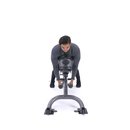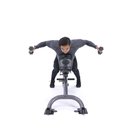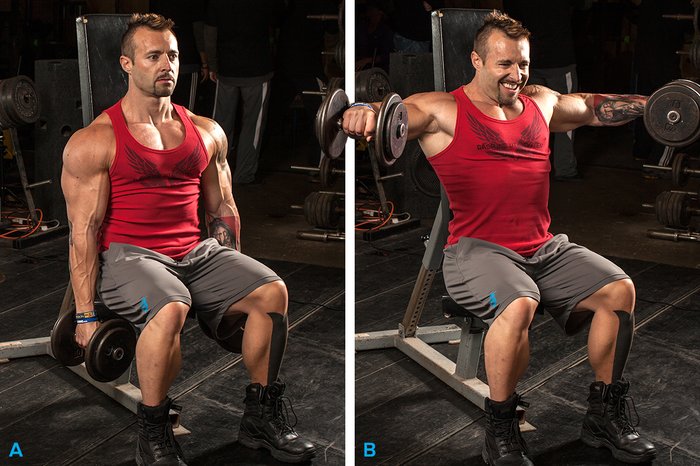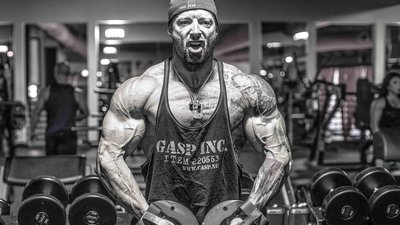My delts were formerly a weakness, and it took me a long time to figure out why. Of course, I wasn't alone in this quandary. Plenty of people have been in the same spot, and they often respond by going whole-hog with overhead presses. They press more weight, more often, and think that will solve everything.
When I got serious about presses, however, I honestly didn't feel I got any benefit from them. I started beating the shit out of my elbows, and I just wasn't feeling the mind-muscle connection. Sound familiar?
So I changed up my routine and stopped trying to follow the supposedly "normal" way of doing things. Over the past year, I've maybe done presses once every six weeks. And here's the thing: My delts have actually improved! It's certainly given my elbows a rest, too.
My new approach isn't easy, though. If you know me at all, that won't come as a surprise. I've put some of my friends, including Steve Cook, through this routine, and they agreed that it was as hard as anything they'd done. I'm sure you will, too.
Train Delts Like You Mean It
About 18 months ago, I decided to prioritize training my delts and biceps—they were a weakness that needed extra work. It's a good idea to limit this approach to no more than one or two muscle groups at a time, and this routine is perfect to help you transform weakness into a weapon—so long as you approach it right.
This routine is perfect to help you transform weakness into a weapon—so long as you approach it right.
To get the most out of this routine, I recommend training shoulders first after a rest day. I'll also usually train my most important groups every five days while still following a seven-day split, which means they get hit a bit more frequently than other body parts.
I wouldn't train delts the day after back or legs, which are workouts that typically exhaust me. You want to have as full a tank as possible for this routine.
Another thing I do with weaker body parts is make sure my total calories are substantially more than I'm burning. Not only do I bump up my calories when emphasizing growth to ensure I'm not leaving any stone unturned, I take supplements that support growth and strength gains.
Harness a Different Type of Intensity
I've tried the Dorian Yates-style very-heavy HIT approach in the past, and it worked. But along the way, I gained more injuries than I could justify. Those injuries forced me into going with high reps.
Interestingly, I discovered I had a much better response to high volume than extremely heavy weight, so I steered my training in that direction. I found that increasing my training intensity through lower rest periods and higher volume really boosted sarcoplasmic hypertrophy. I may not have been putting up as much weight with this approach, but it was effective in developing that fuller, rounder look.
But make no mistake—this doesn't feel any less intense than heavier training. I can't pick my nose after this routine. I'm always seeking that failure point. Every single working set is about failure, without a doubt. I never save myself for some other set. I know that total failure is going to help me achieve success.
Currently, my shoulder routine goes head by head from rear to front to middle, with a giant-set finisher that polishes off all three. Here's the routine, plus specific tips on how to make it work for you.



BodyFit
$6.99/month- 2,500+ expert-created single workouts
- 3,500+ how-to exercise videos
- Detailed workout instruction
- Step-by-step workout tips
- Training at gym or at home
- Access to Workout Plans
- Access to Bodyfit App
- Store Discounts
Already have a Bodybuilding.com account with BodyFit? Sign In

What comes with BodyFit?

- Instructional Videos
Don't risk doing a workout improperly! Avoid injury and keep your form in check with in-depth instructional videos.

- How-to Images
View our enormous library of workout photos and see exactly how each exercise should be done before you give it a shot.

- Step-by-Step Instructions
Quickly read through our step-by-step directions to ensure you're doing each workout correctly the first time, every time.

Rear Delts Get the Mind-Muscle Connection
I start my rear-delt work face-down on an incline bench. I've found that when I relax my index and middle fingers so that all the weight is placed on my outside fingers, I better isolate the rear delts. This may seem trivial, but it's helped me establish a mind-muscle link that didn't exist before.
I do 8-10 reps with my palms facing behind me, index and middle fingers relaxed, allowing the weight to fall to the outside of my hands. Once I can't do any more of those, I turn my palms so they're facing each other, which provides additional assistance from my traps and rhomboids.
This gives me extra strength, so I'll do that for the remainder of my reps, then get off the bench and do the same movement in the bent-over position with the exact same weight in the exact same fashion: palms facing the rear at first, then facing each other for a total of 15 reps.
If you have a training partner, have him or her tap your rear delts to help intensify your mind-muscle connection. It's hard to feel the rear delts, but by starting on a bench, you can better isolate them. When you're just starting out, it's easy to bring in your traps and other larger muscle groups that can take over the movement.
Front Delts Together, Then Alternating
Just as when I train rear delts, I perform my first front-delt exercise in a strict manner, and then I loosen up the form so I can cheat a little more and bring in some assisting muscles. All of the supersetted exercises follow that same principle.
I hit my first 15 reps of dumbbell front raises seated on an incline bench. I perform as many reps as I can with both arms (bilaterally), and then switch to unilateral reps as I fatigue. When I stand up, I do another 15 reps, first bilaterally and then unilaterally. Here, I'm no longer focusing on the stretch; instead, I'm more focused on the contraction at the top.
Sometimes I'll do both of these movements with a barbell, but I usually prefer dumbbells. When I use dumbbells, I perform the first 8 reps strictly, using both arms simultaneously. When I can't do any more, I start to alternate sides and use a bit of controlled cheating.
Middle Delts Pick the Right Weight
One upon a time, I thought I only needed big weights and lateral raises to build solid delts. I needed width, so I did lots of heavy side raises to give me those caps. But what I found after many years of heavy training was that I was pulling with my upper traps on lateral raises because I was thinking, "Go up, go up, go up!"

Seated Lateral Raise
In other words, I was making a secondary mover—the upper traps—into a prime mover by elevating my clavicles as I did side raises. So my traps were growing, and they looked good. I was happy with that progression, but I wasn't happy with the delt progression.
The lesson for you? Choose a moderate weight here. Of course, you should still struggle to reach 15 reps.
The Giant-Set Finisher
My shoulder routine ends with a giant set starring a unique move that my friend Nick Holt calls the "chicken row." It's basically a very light dumbbell chest press that you perform standing up. You'll perform 2 sets of this movement, then 2 sets of lateral raises, 2 more sets of chicken rows, and a final agonizing set of front raises.
I'll use weights as light as 5 pounds here, so don't expect to be able to push anything too impressive. This is about wringing the last little bit of energy out of your muscles, and no matter what weight you choose, it'll do it.
How to Make My Routine Your Routine
Learn how to do this routine and see if it works for you. After that, I invite you to customize it. Discovering new ways to do exercises simply comes with experience. For instance, I also love performing front raises with a plate instead of a dumbbell, and I can even do an entire shoulder workout with just plates.
However, when you make big changes, stick with them for at least three months to see if they work for you. When you make wholesale changes to your training frequently, it's hard to pinpoint exactly what's working. You'll never know for sure if you keep swapping things around all the time. Ask yourself, "Did I get a better pump? Did I get a better mind-muscle connection? Did I see more development Am I getting stronger?" If the answer is "no" over time, then go on to something else.
To gauge my progress, I check my photos. I don't measure any body parts; I know mainly by looking in the mirror. I also know by the mind-muscle connection: If I ain't feeling it, it's not working.


